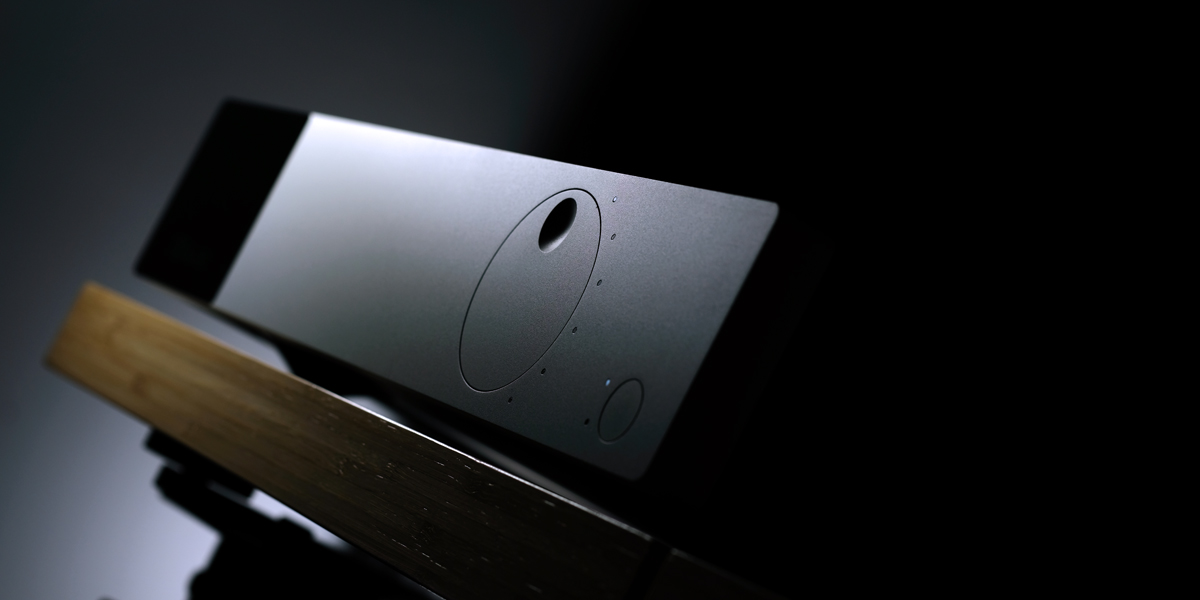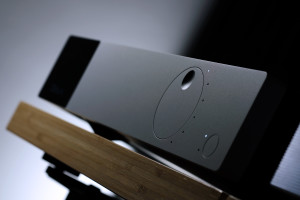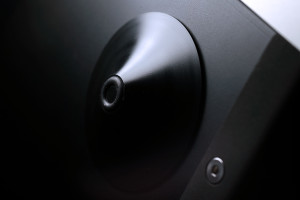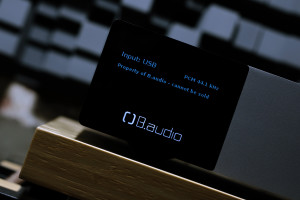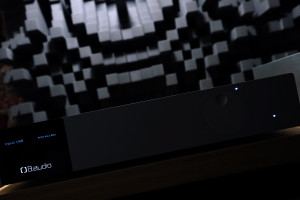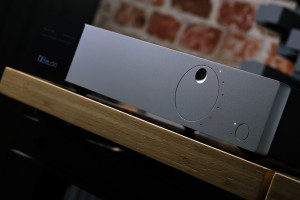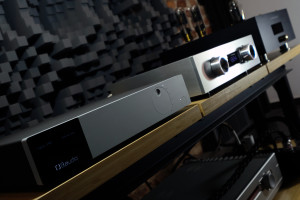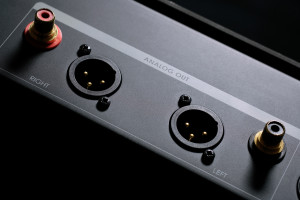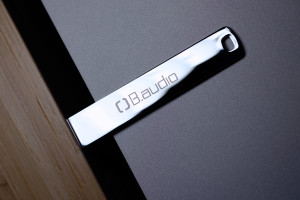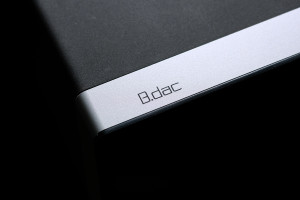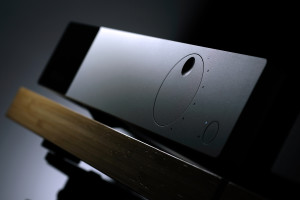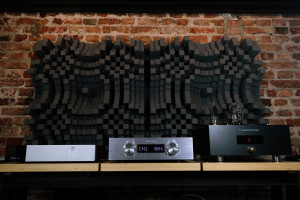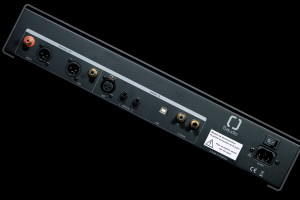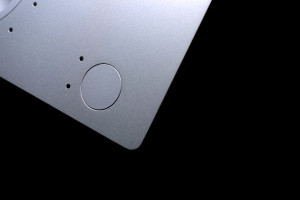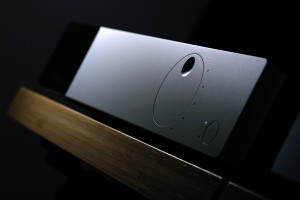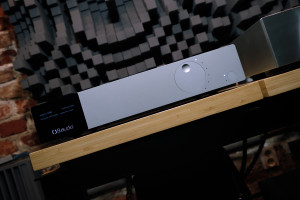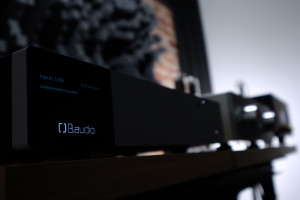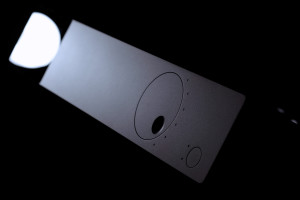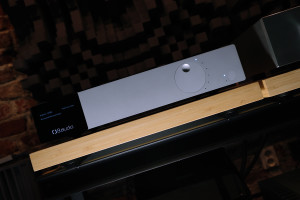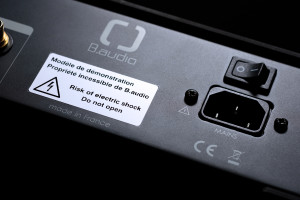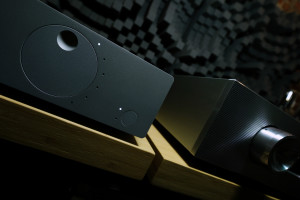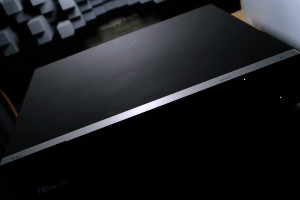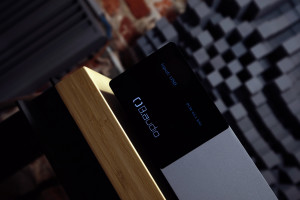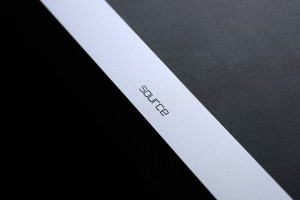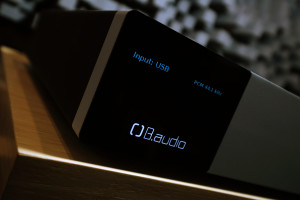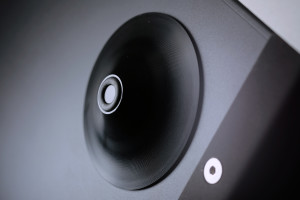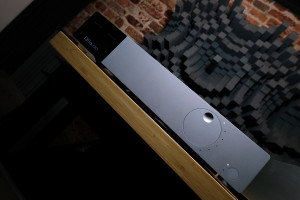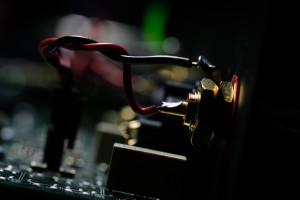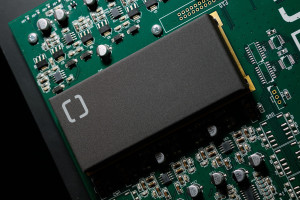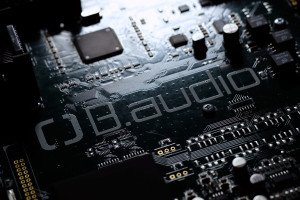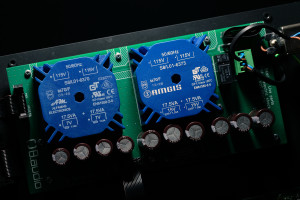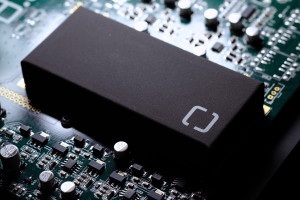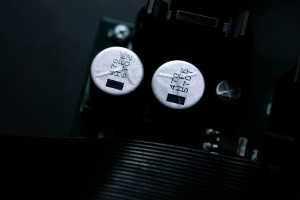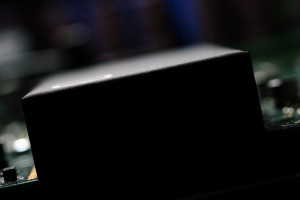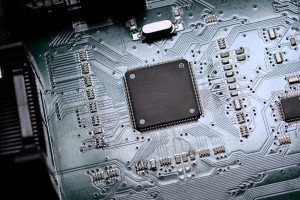Just several months past becoming formally operational, the B.audio company was awarded with space in the newcomer zone at Munich’s MOC. Since many criteria have to be met in order to be granted this privilege, such a debut surely was very successful, netted attention of enthusiasts and press and that’s how B.audio B.dac became this review’s main dish. Enjoy!
Introduction
One can’t just talk himself into MOC’s freshmen place as its charge-free slots are very limited and competition to occupy these is fierce. B.audio’s appearance, involvement and goods won them the golden ticket. The word was that the French team of three exploited the place rather well to net quite the feedback from visitors and press, thus decided to secure space of their own one year later. Truth be told, I somehow missed B.audio’s first public rodeo yet was able to visit them in 2018. Long story’s short, this company’s goods showcased on tastefully executed display looked very much like fully blossomed efforts which rapidly piqued my interest. Once an opportunity to review one of those struck, I was in.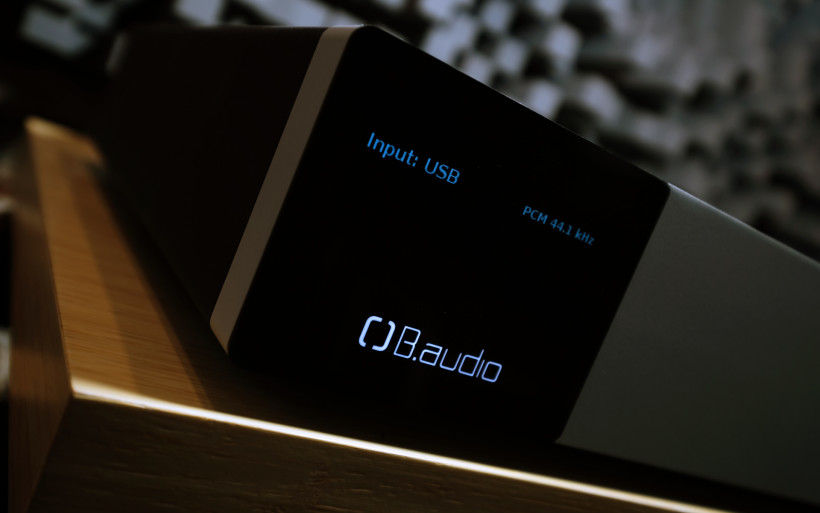 Although this story had its origin in Munich, it took a while for a loaner to arrive, whereas my contact at B.audio – Sébastien Bermann – provided me with key information about this operation in the meantime. Although officially established in October 2016 in the French town of Mutzig, its R&D started as early as in 2006. It took a decade to create a prototype that would meet its makers’ expectations, whereas one of the driving forces behind the decision to have a proper audio business up and running were positive impressions from various industry people. B.audio was founded by Sébastien and his brother Cédric with support of their father Gérard who got them into audio far earlier.
Although this story had its origin in Munich, it took a while for a loaner to arrive, whereas my contact at B.audio – Sébastien Bermann – provided me with key information about this operation in the meantime. Although officially established in October 2016 in the French town of Mutzig, its R&D started as early as in 2006. It took a decade to create a prototype that would meet its makers’ expectations, whereas one of the driving forces behind the decision to have a proper audio business up and running were positive impressions from various industry people. B.audio was founded by Sébastien and his brother Cédric with support of their father Gérard who got them into audio far earlier.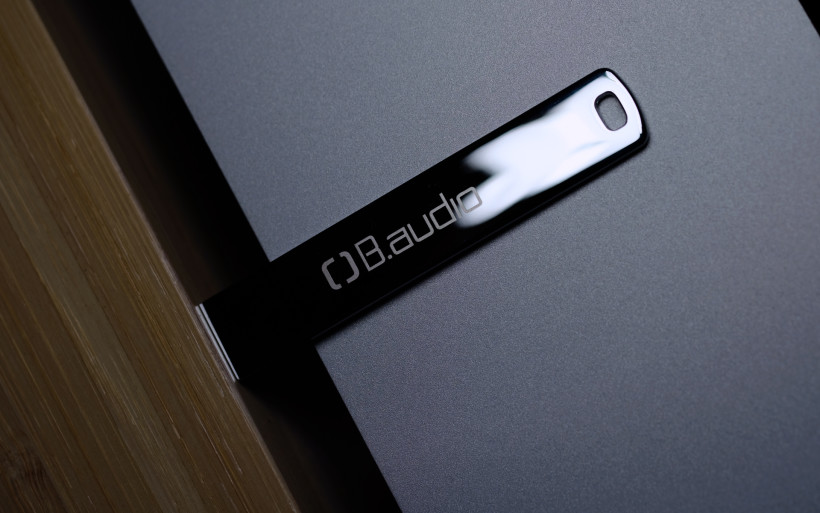 Sébastien is a multi-disciplinary engineer with background in the automotive industry. He’s been employed by international companies such as Mercedes-Benz, has worked on i.e. vehicles’ acoustic comfort optimization and is into measuring, testing and finding ways for improvements, whereas Cédric is a specialist in electronics and signal processing with a decade long experience. He’s been developing highly precise metrology products burdened with problems similar to those found in audio hardware; noise, distortion etc. He DIY-ed his first amp when he was 15 and – needless to say – is the key electronic designer at B.audio, whereas Gérard is experienced business manager.
Sébastien is a multi-disciplinary engineer with background in the automotive industry. He’s been employed by international companies such as Mercedes-Benz, has worked on i.e. vehicles’ acoustic comfort optimization and is into measuring, testing and finding ways for improvements, whereas Cédric is a specialist in electronics and signal processing with a decade long experience. He’s been developing highly precise metrology products burdened with problems similar to those found in audio hardware; noise, distortion etc. He DIY-ed his first amp when he was 15 and – needless to say – is the key electronic designer at B.audio, whereas Gérard is experienced business manager. When asked how their digital adventure came to be, Sébastien explained that the whole B.audio team perceived digital audio as harsh yet extremely detailed, whereas analog carriers lacked micro-details. None of available measures able to fully satisfy our French team eventually laid groundwork for a proprietary technical concept based on eliminating undesirable distortions during the D/A conversion process, which naturally evolved into a DAC later on. Although B.audio’s roadmap also involves other machines (its B.amp power amp is just around the corner scheduled to premiere somewhere in November), the initial agenda was to deliver one product at a time and that’s yet another reason why a DAC was released prior to anything else. I was also told that in order to evaluate their goods, Sébastien involves different people with their own hardware and B.audio’s reference platform is on the job as well.
When asked how their digital adventure came to be, Sébastien explained that the whole B.audio team perceived digital audio as harsh yet extremely detailed, whereas analog carriers lacked micro-details. None of available measures able to fully satisfy our French team eventually laid groundwork for a proprietary technical concept based on eliminating undesirable distortions during the D/A conversion process, which naturally evolved into a DAC later on. Although B.audio’s roadmap also involves other machines (its B.amp power amp is just around the corner scheduled to premiere somewhere in November), the initial agenda was to deliver one product at a time and that’s yet another reason why a DAC was released prior to anything else. I was also told that in order to evaluate their goods, Sébastien involves different people with their own hardware and B.audio’s reference platform is on the job as well.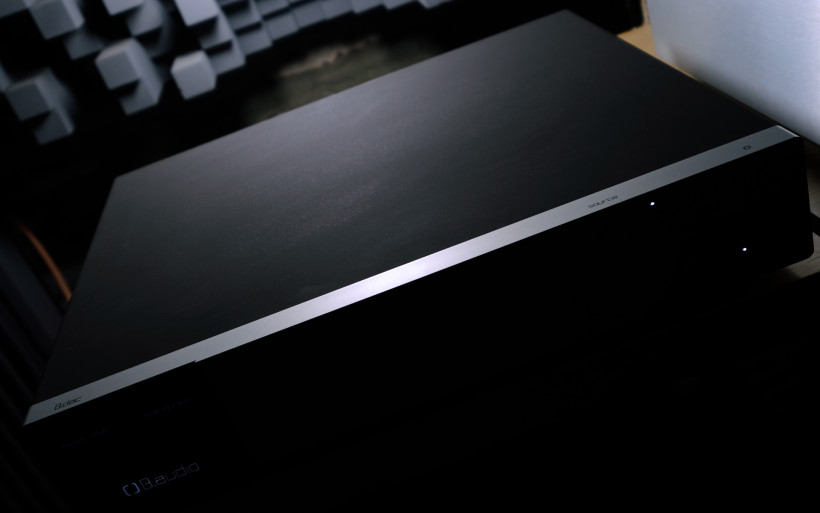 Sébastien provided me with answers to every question I had and was very communicative and professional. Once he fixed a firm delivery date, logistics followed accordingly and I had no reason to complain. The man originally wanted to send me his B.dpr machine. Since currently there’s no way for me to fully evaluate this DAC’s volume control module, the two of us came up with the plan to have its simpler version reviewed instead and that’s how B.audio B.dac became this review’s main dish. And lastly, the ‘B’ part of the company’s name stands for Bermann and also refers to oftentimes unexpected and amazing material found on B-sides.
Sébastien provided me with answers to every question I had and was very communicative and professional. Once he fixed a firm delivery date, logistics followed accordingly and I had no reason to complain. The man originally wanted to send me his B.dpr machine. Since currently there’s no way for me to fully evaluate this DAC’s volume control module, the two of us came up with the plan to have its simpler version reviewed instead and that’s how B.audio B.dac became this review’s main dish. And lastly, the ‘B’ part of the company’s name stands for Bermann and also refers to oftentimes unexpected and amazing material found on B-sides.
Build
The product arrived in a regular double cardboard box. Dressed in a nice cloth and placed in-between two foam forms, it surely had a comfy and secure trip. A fancy pendrive with necessary software and a regular power cord were also found inside. This sort of packaging and accessories are the industry standard and the product itself arrived unharmed.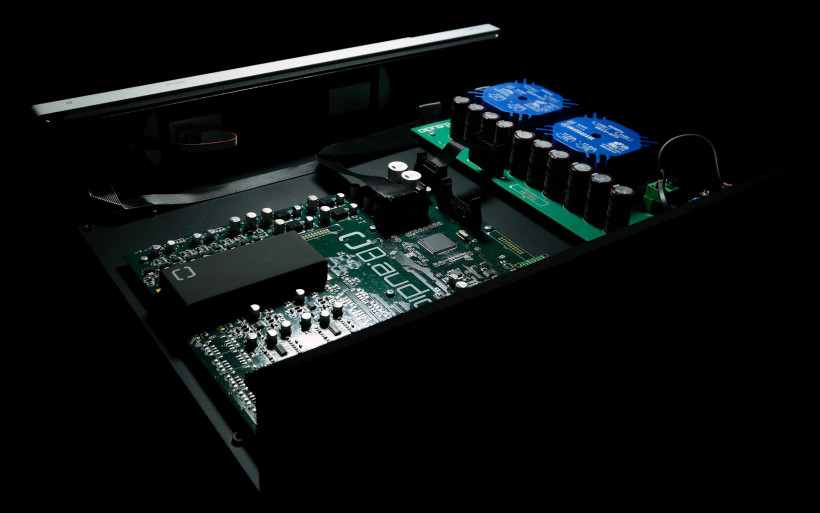 B.audio B.dac weighs 7.4kg and measures (WxHxD) 450x91x375mm, thus is a machine of sleek proportions perfectly fit to be used on regularly sized racks. On this count it’s not abnormal at all, on the contrary to its looks. Put shortly and subjectively, this is one of the most gorgeously looking DACs known to this reporter. The French team outdid themselves with their visually Scandinavian and tastefully executed design. Many audio operations with years of experience in the industry wouldn’t be ashamed of such a looker. B.audio might be newcomers yet their source shows rather well how skilled this team is.
B.audio B.dac weighs 7.4kg and measures (WxHxD) 450x91x375mm, thus is a machine of sleek proportions perfectly fit to be used on regularly sized racks. On this count it’s not abnormal at all, on the contrary to its looks. Put shortly and subjectively, this is one of the most gorgeously looking DACs known to this reporter. The French team outdid themselves with their visually Scandinavian and tastefully executed design. Many audio operations with years of experience in the industry wouldn’t be ashamed of such a looker. B.audio might be newcomers yet their source shows rather well how skilled this team is.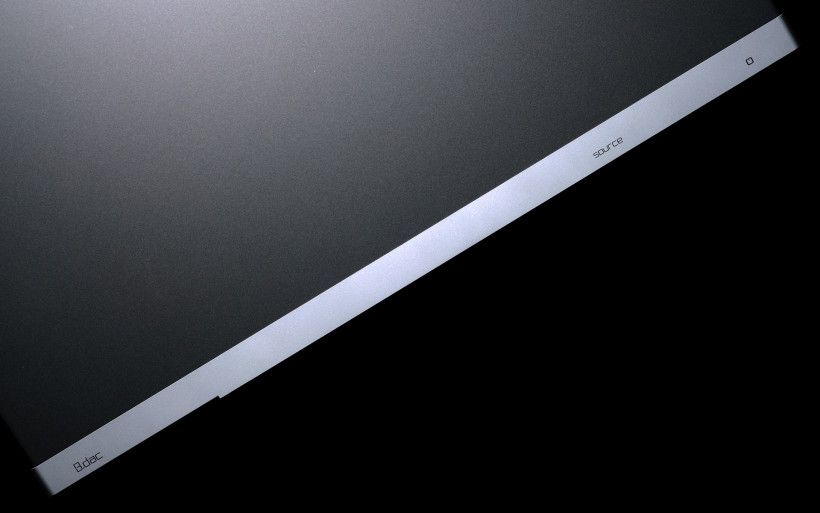 B.audio B.dac’s thick front panel made out of aluminium is nearly seamlessly married to the enclosure and the outcome is very nice. The only visible thing which obviously sets these two elements apart is their different colour scheme. The machine’s front isn’t crowded at all. Behind large black acrylic glass, a big and quite bright manufacturer’s logo placed near the lower ledge neighbours with a small monochromatic LED located higher. The latter displays two lines of light gray text; the upper one shows currently used digital input, sampling rate and data type, whereas the line right below kept bluntly informing me that my loaner is a demonstration product not for sale. I’ve found this custom-coded preventive measure quite entertaining early on and thoughtful in the long run. All visible content is small, of resolution low enough to spot single pixels up close and one really has to have a sharp eye to see what’s going on in there from a distance. This wasn’t a drawback for yours truly as a single digit displayed on his daily driver’s Nixie tubed front is all he sees daily.
B.audio B.dac’s thick front panel made out of aluminium is nearly seamlessly married to the enclosure and the outcome is very nice. The only visible thing which obviously sets these two elements apart is their different colour scheme. The machine’s front isn’t crowded at all. Behind large black acrylic glass, a big and quite bright manufacturer’s logo placed near the lower ledge neighbours with a small monochromatic LED located higher. The latter displays two lines of light gray text; the upper one shows currently used digital input, sampling rate and data type, whereas the line right below kept bluntly informing me that my loaner is a demonstration product not for sale. I’ve found this custom-coded preventive measure quite entertaining early on and thoughtful in the long run. All visible content is small, of resolution low enough to spot single pixels up close and one really has to have a sharp eye to see what’s going on in there from a distance. This wasn’t a drawback for yours truly as a single digit displayed on his daily driver’s Nixie tubed front is all he sees daily.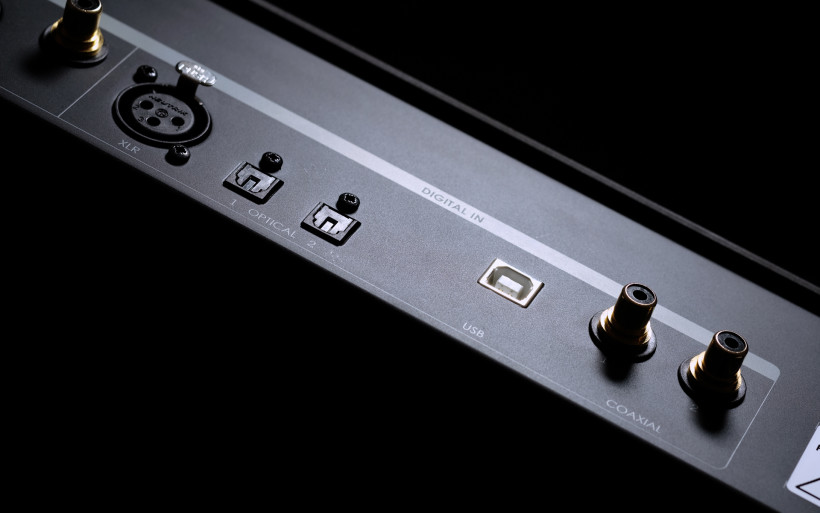 B.dac’s acrylic section is finely merged with aluminium front panel to contrast nicely. The connection between the two injects some distinctiveness and character to the product and in general ups the ante on its visuals. A large endlessly rotating input selection wheel found near the opposite end operates perfectly well; makes no sound, turns very smoothly and doesn’t protrude above its surroundings at all. One diode lit up out of six on the wheel’s right side indicates a digital input currently on duty and a button right next to it is the secondary on/off switch. The machine wakes up almost instantly and let me stress again that both its fit’n’finish and overall design are top notch. I wouldn’t change a thing in it.
B.dac’s acrylic section is finely merged with aluminium front panel to contrast nicely. The connection between the two injects some distinctiveness and character to the product and in general ups the ante on its visuals. A large endlessly rotating input selection wheel found near the opposite end operates perfectly well; makes no sound, turns very smoothly and doesn’t protrude above its surroundings at all. One diode lit up out of six on the wheel’s right side indicates a digital input currently on duty and a button right next to it is the secondary on/off switch. The machine wakes up almost instantly and let me stress again that both its fit’n’finish and overall design are top notch. I wouldn’t change a thing in it.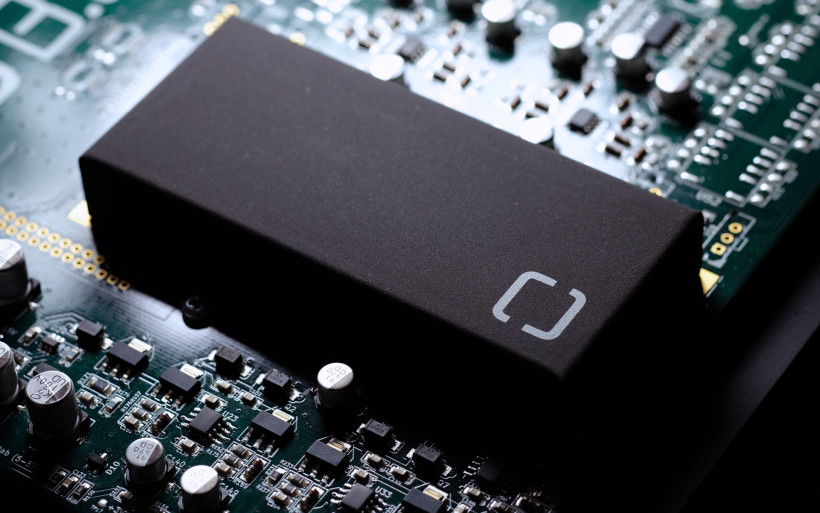 A remote control is the only thing that B.dac is missing. Once its ask factors in, such a mandatory item shouldn’t arrive as an exclusive for its pricier kin only. Five figures on the former’s price tag indicate that at least a very simple unit capable of switching between inputs and dimming all lights/text if desired should’ve been provided. The machine’s top and sides form one U-shaped piece which is nothing unusual, though its coating is. Pleasantly soft and satin alike, not only it resembles very specific paint job found on Italian Aqua Hifi’s machines, but also elevates the quality sensation one gets past closer inspection. B.dac’s rear is occupied by the usual suspects; two analog outputs (RCA and XLR), six digital inputs (AES/EBU, 2x TOSLINK, asynchronous USB and 2x coaxial S/PDIF) and an IEC inlet with the main on/off switch nearby. The machine sits on four round aluminium feet loaded with rubber rings. As far as its specs go, via USB it’s capable of PCM up to 32bit/384kHz and DSD up to DSD256, whereas DoP goes up to DSD128.
A remote control is the only thing that B.dac is missing. Once its ask factors in, such a mandatory item shouldn’t arrive as an exclusive for its pricier kin only. Five figures on the former’s price tag indicate that at least a very simple unit capable of switching between inputs and dimming all lights/text if desired should’ve been provided. The machine’s top and sides form one U-shaped piece which is nothing unusual, though its coating is. Pleasantly soft and satin alike, not only it resembles very specific paint job found on Italian Aqua Hifi’s machines, but also elevates the quality sensation one gets past closer inspection. B.dac’s rear is occupied by the usual suspects; two analog outputs (RCA and XLR), six digital inputs (AES/EBU, 2x TOSLINK, asynchronous USB and 2x coaxial S/PDIF) and an IEC inlet with the main on/off switch nearby. The machine sits on four round aluminium feet loaded with rubber rings. As far as its specs go, via USB it’s capable of PCM up to 32bit/384kHz and DSD up to DSD256, whereas DoP goes up to DSD128.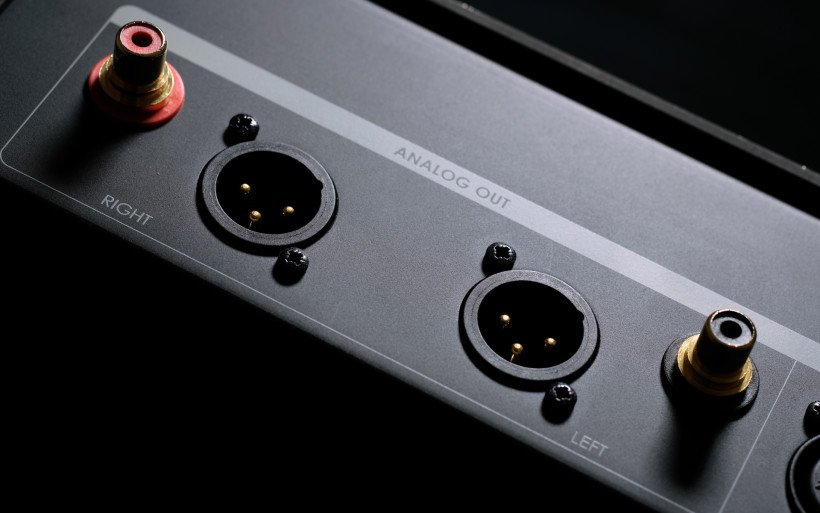 Getting down to B.dac’s innards was a breeze. Six screws removed allowed me to easily detach its hood and take a good long look inside. Five key sections were spread among two separate PCBs. The one with two toroidal transformers by Amgis (each for digital and analog) was the power supply, whereas everything else the other board sported. Amanero based USB input was the only recognizable element as every other important silicon had its top purposely polished to remain mysterious to those who excessively focus on single components. What’s known is that B.dac exploits ARM processor and DSP loaded with in-house developed convolution engine which applies its own linear phase filter with reduced pre-ringing. And yes, this review’s star is of upsampling breed.
Getting down to B.dac’s innards was a breeze. Six screws removed allowed me to easily detach its hood and take a good long look inside. Five key sections were spread among two separate PCBs. The one with two toroidal transformers by Amgis (each for digital and analog) was the power supply, whereas everything else the other board sported. Amanero based USB input was the only recognizable element as every other important silicon had its top purposely polished to remain mysterious to those who excessively focus on single components. What’s known is that B.dac exploits ARM processor and DSP loaded with in-house developed convolution engine which applies its own linear phase filter with reduced pre-ringing. And yes, this review’s star is of upsampling breed. Each key circuitry element (DSP, clock, DAC, output stages, DC servo) has its dedicated power regulation unit. There was no way for me to dismount the rather large and mysterious box found on the main board without damaging it. Sébastien explained that it houses B.dac’s D/A conversion module based on multibit ΔΣ modules (Burr-Browns are my guess) and B.audio’s proprietary SJR (a short for ‘Source Jitter Removal’) scheme. Its goal is to fully eliminate all incoming jitter without the need of an external clock link. A clean clock generator decoupled from the source signal clock is said to provide optimal timing for D/A conversion and remove the well-known digital harshness. The product’s output stage is executed in dual mono fashion and loaded with low phase deviation filters. I was informed yet again that these are applied in order to have signal as accurate as possible and with its dynamics and micro-information preserved. And lastly, a specific multi-pole DC servo was developed to allow direct-coupling operation without risking presence of voltage offset at output.
Each key circuitry element (DSP, clock, DAC, output stages, DC servo) has its dedicated power regulation unit. There was no way for me to dismount the rather large and mysterious box found on the main board without damaging it. Sébastien explained that it houses B.dac’s D/A conversion module based on multibit ΔΣ modules (Burr-Browns are my guess) and B.audio’s proprietary SJR (a short for ‘Source Jitter Removal’) scheme. Its goal is to fully eliminate all incoming jitter without the need of an external clock link. A clean clock generator decoupled from the source signal clock is said to provide optimal timing for D/A conversion and remove the well-known digital harshness. The product’s output stage is executed in dual mono fashion and loaded with low phase deviation filters. I was informed yet again that these are applied in order to have signal as accurate as possible and with its dynamics and micro-information preserved. And lastly, a specific multi-pole DC servo was developed to allow direct-coupling operation without risking presence of voltage offset at output.
Sound
In order to review B.audio B.dac, my trusty Asus UX305LA laptop fed either this machine or LampizatOr Pacific DAC (KR Audio T-100 DHTs + KR Audio 5U4G Ltd. Ed.). One of the two then passed signal to either Kinki Studio EX-M1 or Trilogy 925 integrated amps and these alternately fed Boenicke W8 floorstanders. Both DACs were connected to Gigawatt’s PF-2 power strip via identical 2m long C-MARC power cords by LessLoss, whereas two also identic pairs of Amber-modded Audiomica Laboratory Erys Excellence RCA interconnects hooked them to integrated amps. And early on the iFi audio iGalvanic3.0 + iUSB3.0 team did its usual magic in-between my transport and sources to see which one of the two is more subject to USB tweaks served the British way.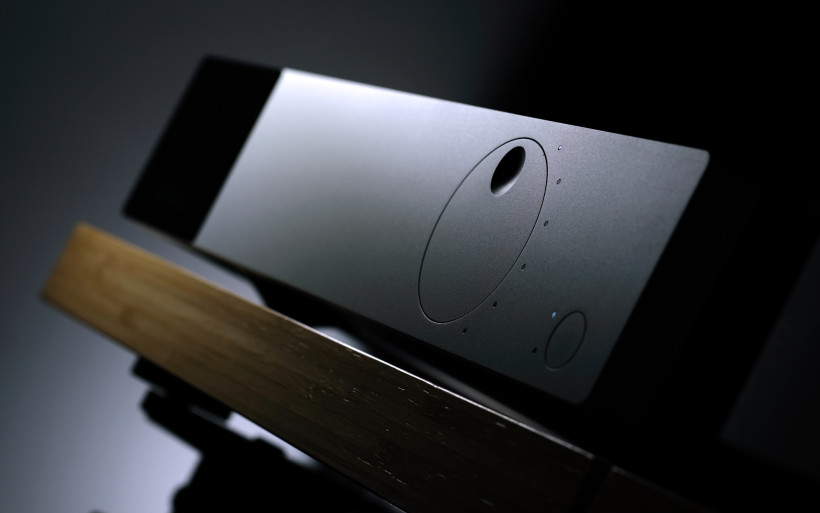 Over the years yours truly had a number of useful experiences with various products designed to strip signal from contamination. These exercises led him to think that music without junk along the road sounds not only generally better but also alike on many counts regardless of a given item’s type. Similar things he’s heard with i.e. C-MARC power cords by LessLoss recently covered here, USB sorters by iFi audio reviewed here and here, Fidata HFLC leash to be found in this place and GigaWatt PC-2 EVO+ power filter reviewed here. All these goods vary in their key purpose, potency and numbers on their price tags. But each on the job led to music calmer, more revealing, livelier and airier with edge and grain lessened and the so-called background darker. Any repertoire served in such fashion simply flows better, less garishness equals to more pleasure and I can fully responsibly say that B.audio B.dac belongs to the cleanly group as well. For two weeks this machine has been expressing loudly and clearly that not only it fits in there perfectly, but also sounds as good as it looks.
Over the years yours truly had a number of useful experiences with various products designed to strip signal from contamination. These exercises led him to think that music without junk along the road sounds not only generally better but also alike on many counts regardless of a given item’s type. Similar things he’s heard with i.e. C-MARC power cords by LessLoss recently covered here, USB sorters by iFi audio reviewed here and here, Fidata HFLC leash to be found in this place and GigaWatt PC-2 EVO+ power filter reviewed here. All these goods vary in their key purpose, potency and numbers on their price tags. But each on the job led to music calmer, more revealing, livelier and airier with edge and grain lessened and the so-called background darker. Any repertoire served in such fashion simply flows better, less garishness equals to more pleasure and I can fully responsibly say that B.audio B.dac belongs to the cleanly group as well. For two weeks this machine has been expressing loudly and clearly that not only it fits in there perfectly, but also sounds as good as it looks.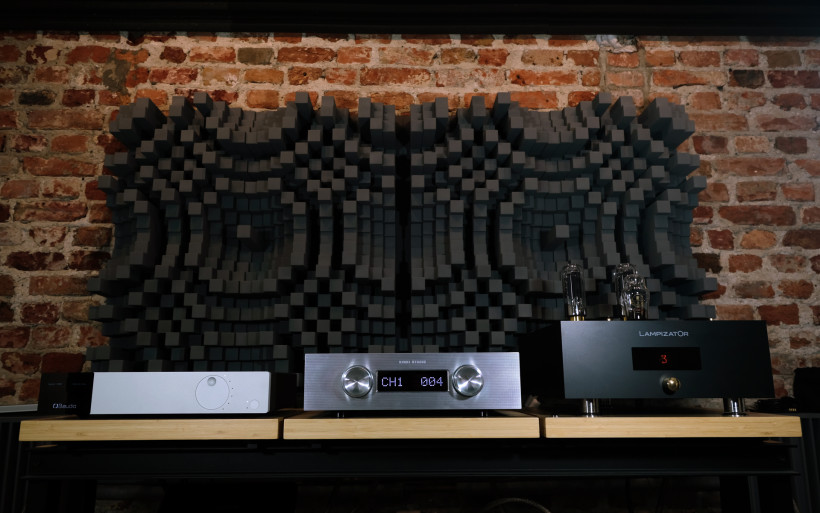 B.audio B.dac quickly revealed itself to be finely tuned and seasoned performer utterly free from any harshness. If this reporter had to describe it with just one word, liquidity would surely be it. A product able to provide perfectly sorted, grainless, organic and smooth experience with no major temperature twists has to be labeled as such. And in order to achieve this outcome, all incoming signal has to be well taken care off, otherwise it won’t happen on its own. The important bit here is that B.audio B.dac sings like so with no additional hardware involved and delivers what’s promised nonetheless. In spite of having Amanero receiver on-board, this machine turned out to be far more resilient to the usual USB tweaks than my reference source based on similar or the very same Italian module.
B.audio B.dac quickly revealed itself to be finely tuned and seasoned performer utterly free from any harshness. If this reporter had to describe it with just one word, liquidity would surely be it. A product able to provide perfectly sorted, grainless, organic and smooth experience with no major temperature twists has to be labeled as such. And in order to achieve this outcome, all incoming signal has to be well taken care off, otherwise it won’t happen on its own. The important bit here is that B.audio B.dac sings like so with no additional hardware involved and delivers what’s promised nonetheless. In spite of having Amanero receiver on-board, this machine turned out to be far more resilient to the usual USB tweaks than my reference source based on similar or the very same Italian module.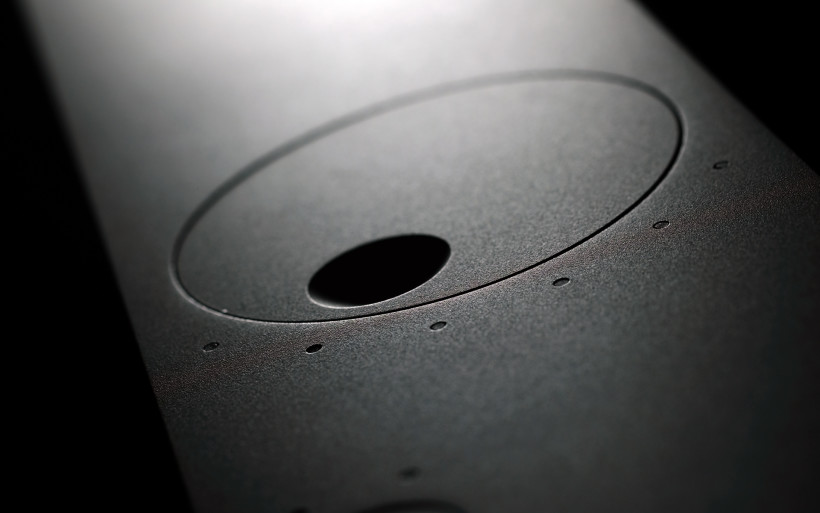 It mattered not whether micro iUSB3.0 was on the job all alone or fronted via galvanic isolator by the same manufacturer. In comparison to B.dac, LampizatOr Pacific benefited from these sorters audibly more. Truth be told, I don’t listen to the latter without these items if it’s fed with music from my laptop and not a fancy transport. Of course I can’t be in 100% sure, but this experience led me to think that the French’s SJR circuitry had to be efficient, otherwise differences between the two DACs with and without USB boxes along the road wouldn’t be this easily distinguishable and audible. B.audio B.dac benefited from both British additions still, but in its case quality improvement introduced by these critters was mild at best, whereas I’ve found them pretty much mandatory in order to squeeze every ounce of musical goodness from my Polish DAC.
It mattered not whether micro iUSB3.0 was on the job all alone or fronted via galvanic isolator by the same manufacturer. In comparison to B.dac, LampizatOr Pacific benefited from these sorters audibly more. Truth be told, I don’t listen to the latter without these items if it’s fed with music from my laptop and not a fancy transport. Of course I can’t be in 100% sure, but this experience led me to think that the French’s SJR circuitry had to be efficient, otherwise differences between the two DACs with and without USB boxes along the road wouldn’t be this easily distinguishable and audible. B.audio B.dac benefited from both British additions still, but in its case quality improvement introduced by these critters was mild at best, whereas I’ve found them pretty much mandatory in order to squeeze every ounce of musical goodness from my Polish DAC.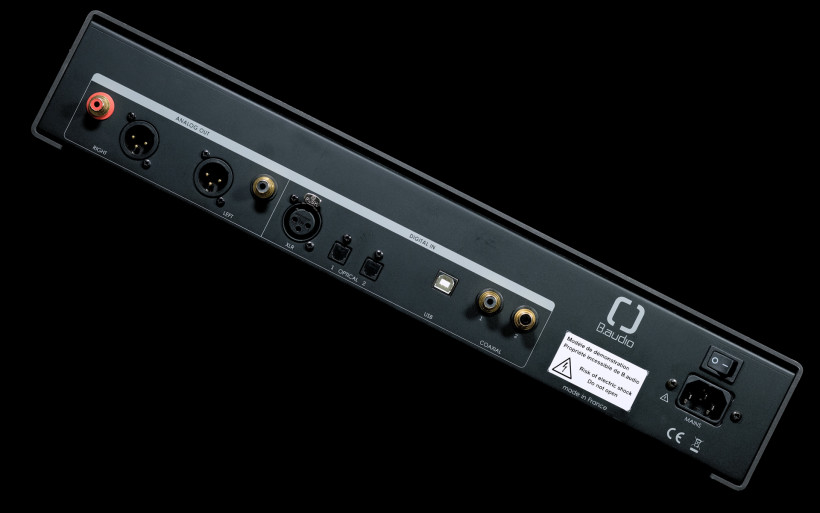 B.audio B.dac compared directly to LampizatOr Pacific quickly revealed its far different voicing. Not a single major thing these two machines had in common, which I’ve found exceptionally entertaining. Switching from one to another netted vastly different results and the more repertoire and hardware shifts were made along the road, the more the French grew on me. But one of the very best things about this deck was its unique sound characteristic. I can’t say, perhaps being familiar with several dozens of different DACs is still not enough, but as of today I’m not able to point my finger at something even remotely similar sound wise within the same group of products. The market is flooded with quality sources, we can pick to our hearts’ content, not falling into the ‘me too’ trap is a task to behold and after familiarizing myself with the B.dac quite well I can fully responsibly say that its makers found their unique and highly engaging voice.
B.audio B.dac compared directly to LampizatOr Pacific quickly revealed its far different voicing. Not a single major thing these two machines had in common, which I’ve found exceptionally entertaining. Switching from one to another netted vastly different results and the more repertoire and hardware shifts were made along the road, the more the French grew on me. But one of the very best things about this deck was its unique sound characteristic. I can’t say, perhaps being familiar with several dozens of different DACs is still not enough, but as of today I’m not able to point my finger at something even remotely similar sound wise within the same group of products. The market is flooded with quality sources, we can pick to our hearts’ content, not falling into the ‘me too’ trap is a task to behold and after familiarizing myself with the B.dac quite well I can fully responsibly say that its makers found their unique and highly engaging voice.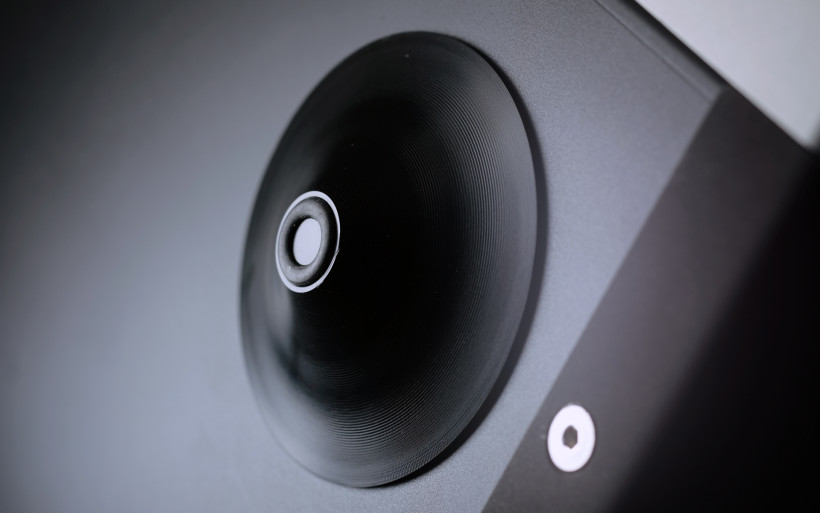 In comparison to my daily source, the French machine sounded rounder, had more weight and bloom downstairs, placed vocals a bit deeper yet the first row’s sides up close, on the soundstage grandeur count it was fully developed albeit a bit smaller and in general was darker. LampizatOr Pacific sounded bigger, quicker and sketched instruments and vocals with extra contour to serve them more precise in effect but also of fully blown proportions. This DAC was clearly of more hi-fi and less romantic sort than B.dac and as such it sounded more spectacular and flamboyant. Also the Pacific delivered it all right away, whereas the calmer French scored gentler and softer start to reveal its generously complex character bit by bit, just as a proper mood-maker would. As you can probably tell by now, two quite opposite voicings clashed.
In comparison to my daily source, the French machine sounded rounder, had more weight and bloom downstairs, placed vocals a bit deeper yet the first row’s sides up close, on the soundstage grandeur count it was fully developed albeit a bit smaller and in general was darker. LampizatOr Pacific sounded bigger, quicker and sketched instruments and vocals with extra contour to serve them more precise in effect but also of fully blown proportions. This DAC was clearly of more hi-fi and less romantic sort than B.dac and as such it sounded more spectacular and flamboyant. Also the Pacific delivered it all right away, whereas the calmer French scored gentler and softer start to reveal its generously complex character bit by bit, just as a proper mood-maker would. As you can probably tell by now, two quite opposite voicings clashed.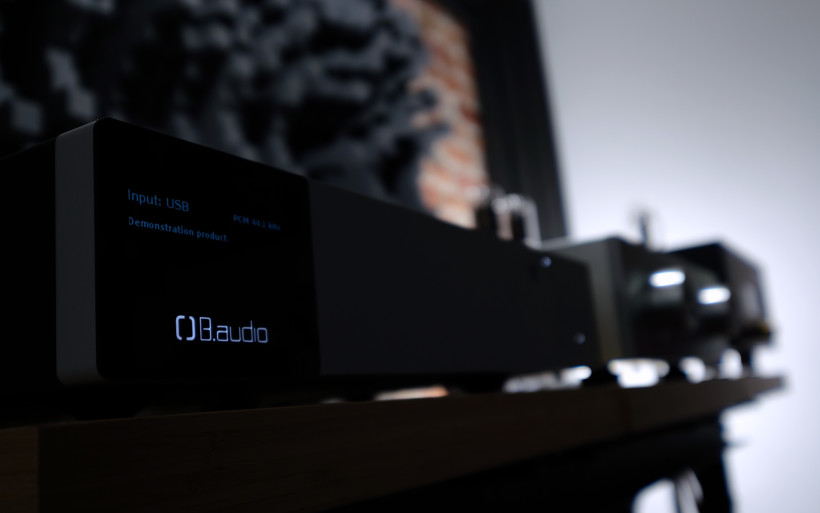 Both machines had my full attention with ease but via different measures. Very resolving, sporty and in general seasoned, LampizatOr Pacific very efficiently nails me to the hot seat, quickly boils my blood with right repertoire and tops this with the ‘just one song more’ syndrome. Its enormous soundstaging capabilities combined with smoothness, downstairs slam crack and heft, clarity, loads of torque, very tangible texturing without any signs of being overdone are what works for this reporter also as an enthusiast, whereas B.audio B.dac doesn’t compete on these counts. Technically it provides the full audiophile care package, but purposely doesn’t go this road exclusively. More syrupy and suave, weightier and with tonal centre of gravity located lower than my daily source, the French doesn’t play the hi-rez game to materialize events in front of a listener as visibly and clearly as the Pacific does, but rather takes him on a trip to its less attended and prettier place instead. The sensation of music served in such a magical and impressively yet unusually engaging way is what B.dac does the best.
Both machines had my full attention with ease but via different measures. Very resolving, sporty and in general seasoned, LampizatOr Pacific very efficiently nails me to the hot seat, quickly boils my blood with right repertoire and tops this with the ‘just one song more’ syndrome. Its enormous soundstaging capabilities combined with smoothness, downstairs slam crack and heft, clarity, loads of torque, very tangible texturing without any signs of being overdone are what works for this reporter also as an enthusiast, whereas B.audio B.dac doesn’t compete on these counts. Technically it provides the full audiophile care package, but purposely doesn’t go this road exclusively. More syrupy and suave, weightier and with tonal centre of gravity located lower than my daily source, the French doesn’t play the hi-rez game to materialize events in front of a listener as visibly and clearly as the Pacific does, but rather takes him on a trip to its less attended and prettier place instead. The sensation of music served in such a magical and impressively yet unusually engaging way is what B.dac does the best.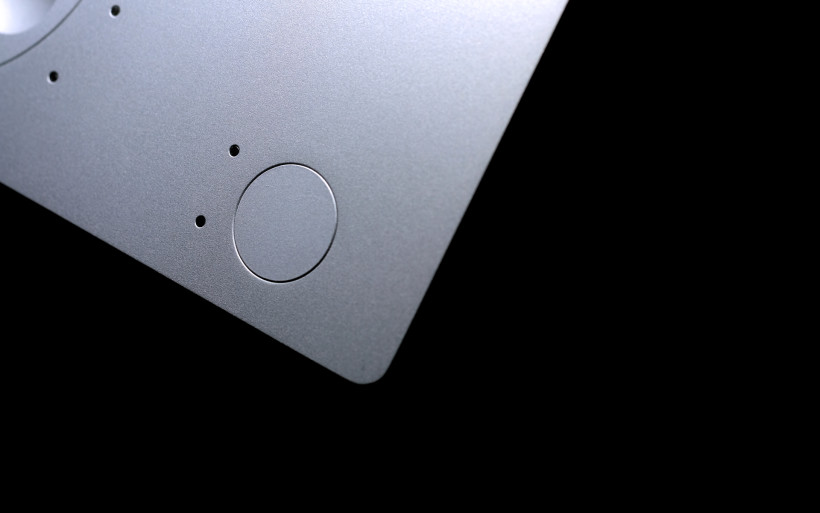 B.audio B.dac’s magic doesn’t run out quickly, though. This is not a machine of merely one trick. It sounds utmost coherently and on purely technical counts such as clarity, control, agility, decay, substance or smoothness it scores very high notes, which leads to a simple conclusion that it’s very much refined product with no obvious downsides. Neither it doesn’t suffer from excessive itchiness, grain or any other unpleasantries associated with digital audio, nor from abnormal heat or cold. In spite of having its bass rounded and very present, not even once I’ve heard its boom, whereas top audible FR was always perfectly pleasant, generously decayed and weighty even when served off the spotlight. With speakers such as mine any shortcomings on imaging count become obvious fast, but here the French delivered as well.
B.audio B.dac’s magic doesn’t run out quickly, though. This is not a machine of merely one trick. It sounds utmost coherently and on purely technical counts such as clarity, control, agility, decay, substance or smoothness it scores very high notes, which leads to a simple conclusion that it’s very much refined product with no obvious downsides. Neither it doesn’t suffer from excessive itchiness, grain or any other unpleasantries associated with digital audio, nor from abnormal heat or cold. In spite of having its bass rounded and very present, not even once I’ve heard its boom, whereas top audible FR was always perfectly pleasant, generously decayed and weighty even when served off the spotlight. With speakers such as mine any shortcomings on imaging count become obvious fast, but here the French delivered as well.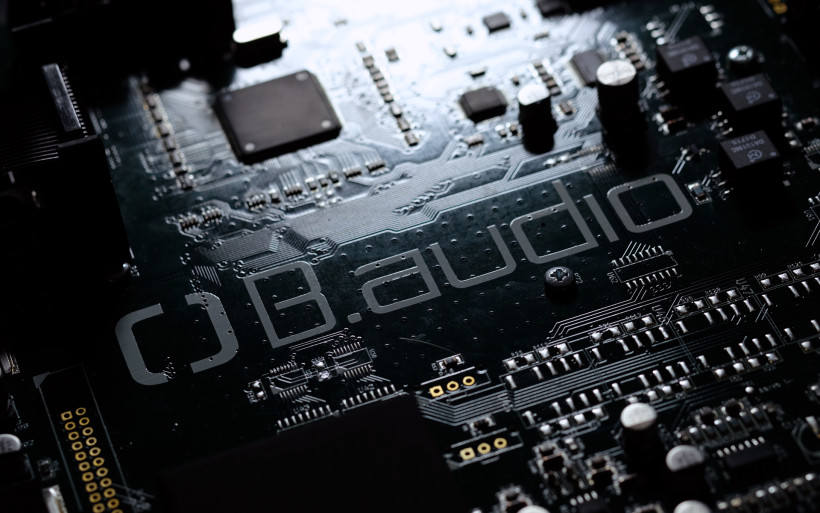 Come to think of it, what the B.audio team did with their DAC was smart. Perfectly clean background combined with textural richness, inherent suaveness, main vocal lines served a bit deeper than usually and in general dark attitude all contribute to the mood-making and romantic effect. Behind quality tuning of this sort no randomness stands but a well-thought plan instead. If implemented carefully, it allows one to sit, relax, proverbially drown in sound served like so and forget about the surrounding world. The B.dac did this exactly thus proved its appurtenance to the club capable of switching the analytical mindset off. In my case there was no crave for more air, contour or information as the product did great on these counts, but it swiftly focused my attention on organic, round and utterly pleasant effect without falling into trap of being overly fuzzy, diluted, dull or not revealing enough for the coin. The French sported its own character via a set of artfully combined traits yet stayed away from the usual drawbacks associated with similar voicing and that’s the main reason why I think it’s as good as it’s unique.
Come to think of it, what the B.audio team did with their DAC was smart. Perfectly clean background combined with textural richness, inherent suaveness, main vocal lines served a bit deeper than usually and in general dark attitude all contribute to the mood-making and romantic effect. Behind quality tuning of this sort no randomness stands but a well-thought plan instead. If implemented carefully, it allows one to sit, relax, proverbially drown in sound served like so and forget about the surrounding world. The B.dac did this exactly thus proved its appurtenance to the club capable of switching the analytical mindset off. In my case there was no crave for more air, contour or information as the product did great on these counts, but it swiftly focused my attention on organic, round and utterly pleasant effect without falling into trap of being overly fuzzy, diluted, dull or not revealing enough for the coin. The French sported its own character via a set of artfully combined traits yet stayed away from the usual drawbacks associated with similar voicing and that’s the main reason why I think it’s as good as it’s unique.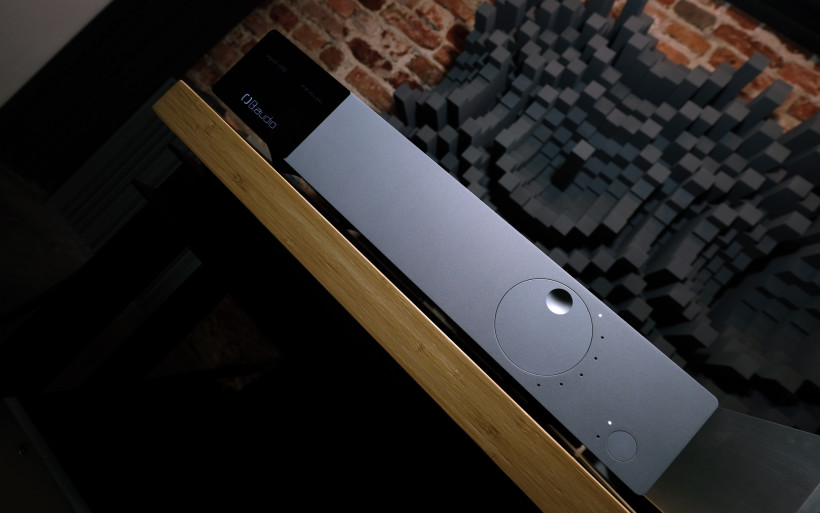 If I had to associate the B.dac with any hardware known to me, the closest one would be probably my calm, hefty, texturally rich and similarly dark yet informative Trilogy 925. This Brit and the French also sport one distinctive feature which impresses me beyond belief; musical presence. Both machines transform events in the soundstage and this space itself into something breathable, substantial, perceptibly physiological and very much dignified. My Lampizator DAC doesn’t fall short on this count, but airier by nature it does the same job in more hifi oriented thus different and also less magical way. Who knows, perhaps heftier and more intimate Golden Gate DAC by LampizatOr would’ve competed or bested the French on this count, yet not owning it any longer I can’t say.
If I had to associate the B.dac with any hardware known to me, the closest one would be probably my calm, hefty, texturally rich and similarly dark yet informative Trilogy 925. This Brit and the French also sport one distinctive feature which impresses me beyond belief; musical presence. Both machines transform events in the soundstage and this space itself into something breathable, substantial, perceptibly physiological and very much dignified. My Lampizator DAC doesn’t fall short on this count, but airier by nature it does the same job in more hifi oriented thus different and also less magical way. Who knows, perhaps heftier and more intimate Golden Gate DAC by LampizatOr would’ve competed or bested the French on this count, yet not owning it any longer I can’t say. The more informative and airier LampizatOr Pacific differentiated both electronics and repertoire better than the B.dac and in general I’ve found the former to be of even higher tier sound wise. But after days of setup swaps and going through a fair part of my music collection, I admired the French for its distinctiveness, overall seasoning, fabulous tear-jerking potential and far less demanding attitude towards associated hardware. It’ll get along fine with more decks and speakers than my daily driver if pleasure and not revealing potential is at stake. The Pacific is the best DAC among those known to me for a number of reasons and a very useful journalistic tool as well, yet some poorly recorded songs it doesn’t sing too often, whereas the B.dac delivered on this count evenly regardless of the content. This journo is perfectly happy with the insightful Polish machine, but as an enthusiast with the cookie-cutter mindset he’d surely be utmost pleased with the B.dac. This was very clear with heavyweight music along the lines of Sepultura, Skyforger, AC/DC and extremes such as Sunn O))). Such repertoire the French softened, made it thicker, heavier, less piercing and insightful, thus injected valuable joy in the process to oftentimes net spectacular results. The secret was in making artificially sounding and sharpish rock/metal tunes prettier than they were but also preserving their inherent drive and severity without excessively diluting the core message. This translates to such music served from the best side possible yet its claptrap carefully limited. The B.dac did fabulously on these counts.
The more informative and airier LampizatOr Pacific differentiated both electronics and repertoire better than the B.dac and in general I’ve found the former to be of even higher tier sound wise. But after days of setup swaps and going through a fair part of my music collection, I admired the French for its distinctiveness, overall seasoning, fabulous tear-jerking potential and far less demanding attitude towards associated hardware. It’ll get along fine with more decks and speakers than my daily driver if pleasure and not revealing potential is at stake. The Pacific is the best DAC among those known to me for a number of reasons and a very useful journalistic tool as well, yet some poorly recorded songs it doesn’t sing too often, whereas the B.dac delivered on this count evenly regardless of the content. This journo is perfectly happy with the insightful Polish machine, but as an enthusiast with the cookie-cutter mindset he’d surely be utmost pleased with the B.dac. This was very clear with heavyweight music along the lines of Sepultura, Skyforger, AC/DC and extremes such as Sunn O))). Such repertoire the French softened, made it thicker, heavier, less piercing and insightful, thus injected valuable joy in the process to oftentimes net spectacular results. The secret was in making artificially sounding and sharpish rock/metal tunes prettier than they were but also preserving their inherent drive and severity without excessively diluting the core message. This translates to such music served from the best side possible yet its claptrap carefully limited. The B.dac did fabulously on these counts.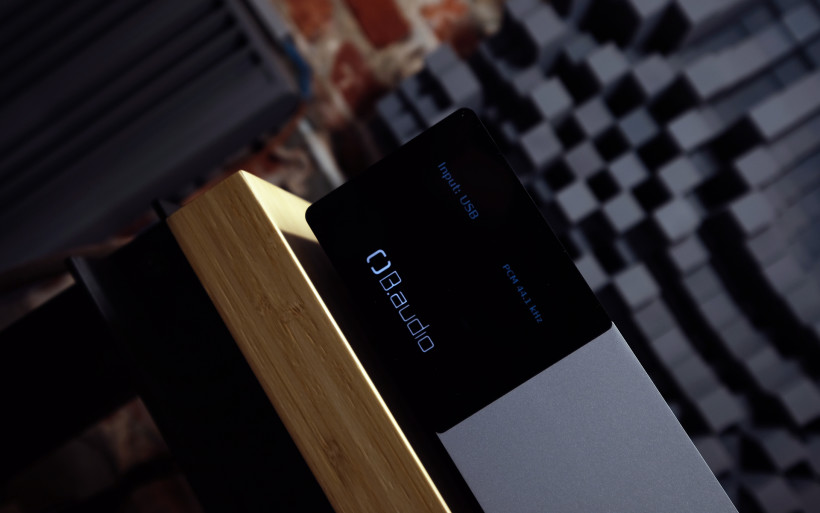 And lastly, one spot on hardware synergy emerged past extensive listening sessions. B.audio B.dac benefits from snappy, airy and openly sounding companions, thus it comes as no surprise that with Kinki Studio EX-M1 it was a perfect match for my speakers. This setup sounded utmost impressively, whereas LessLoss C-MARC power cords efficiently extracted the very best from both machines without altering them in any way. Extremely happy especially with agile and heavy repertoire, Boenicke W8 sported massive bass slam always in check, not a hint of boom was present. Heck, even iFi boxes were off the table. The Trilogy 925 was a no go in the long run, simply because its similar voicing emphasized B.dac’s core virtues yet left agility and openness pretty much intact. This led to the effect pleasant although too syrupy to my ears and the same rule applied to thick sounding power cables by Audiomica. On lesser scale, but these leashes acted similarly.
And lastly, one spot on hardware synergy emerged past extensive listening sessions. B.audio B.dac benefits from snappy, airy and openly sounding companions, thus it comes as no surprise that with Kinki Studio EX-M1 it was a perfect match for my speakers. This setup sounded utmost impressively, whereas LessLoss C-MARC power cords efficiently extracted the very best from both machines without altering them in any way. Extremely happy especially with agile and heavy repertoire, Boenicke W8 sported massive bass slam always in check, not a hint of boom was present. Heck, even iFi boxes were off the table. The Trilogy 925 was a no go in the long run, simply because its similar voicing emphasized B.dac’s core virtues yet left agility and openness pretty much intact. This led to the effect pleasant although too syrupy to my ears and the same rule applied to thick sounding power cables by Audiomica. On lesser scale, but these leashes acted similarly.
Summary
It’s exceptionally risky for a newcomer operation to introduce a very expensive DAC as the portfolio opener. Before going the costly route, even well-established businesses think it through many times over. Competition is fierce, numerous, market for pricey digital hardware is limited and affordable products quite effortlessly throw punches far above their ask these days. That’s why any audio house has to come up with something truly unique to succeed, especially new ones. In many cases the battle’s lost before it even starts for good. Not for B.audio, though. For years this team of three has been readying a blade which I’ve found sharp, pointy and lethal enough to see them as equipped properly for this fight. That I’m sure of.
Past several hours into this assignment I had a major déjà vu. If I hadn’t known who made B.dac yet had to take an educated guess, a group of freshmen with their first machine surely wouldn’t be it. I’d put my money on a product developed, tuned and built by a team of skilled people with many years of experience in the audio industry and the very same impression I had past the COS Engineering D1 adventure many springs ago. The French is executed as nicely, behaves as predictably, is also free from DIY and feels like a properly costly affair it obviously is.
I grew fond of B.audio B.dac not because of the above, though. Once its steep ask factors in, nice visuals or pricey feeling aren’t luxurious additives but mandatory requirements instead. The French has this good and sorted, but what really impressed me is its unique voicing. I can’t name any other DAC which would sing as enchantingly and invitingly as this one, but with the usual drawbacks of such sound characteristic as limited at the same time. It can be easily labeled as enormous joy provider, mood-maker and liquid performer of very high quality. After taking all B.dac’s virtues into account, I keep my fingers crossed for its success. Although expensive, it’s a well-polished gem nonetheless and as such it fully deserves recognition. Very nice first effort from the B.audio team and ‘till next time!
Associated equipment:
- Amplifiers: Trilogy 925, Kinki Audio EX-M1
- Sources: LampizatOr Pacific (KR Audio T-100 + KR Audio 5U4G Ltd. Ed.)
- Speakers: Boenicke Audio W8
- Transports: Asus UX305LA
- Speaker cables: Forza AudioWorks Noir Concept, Audiomica Laboratory Celes Excellence
- Interconnects: Audiomica Laboratory Erys Excellence
- Power components: Gigawatt PF-2 + Gigawatt LC-2 MK2 + Forza AudioWorks Noir Concept/Audiomica Laboratory Ness Excellence/LessLoss C-MARC
- Rack: Franc Audio Accesories Wood Block Rack
- Music: NativeDSD
Retail prices of reviewed components in EU (incl. VAT):
- B.audio B.dac: €11‘900
- B.audio B.dpr: €14‘500
Manufacturer: B.audio


